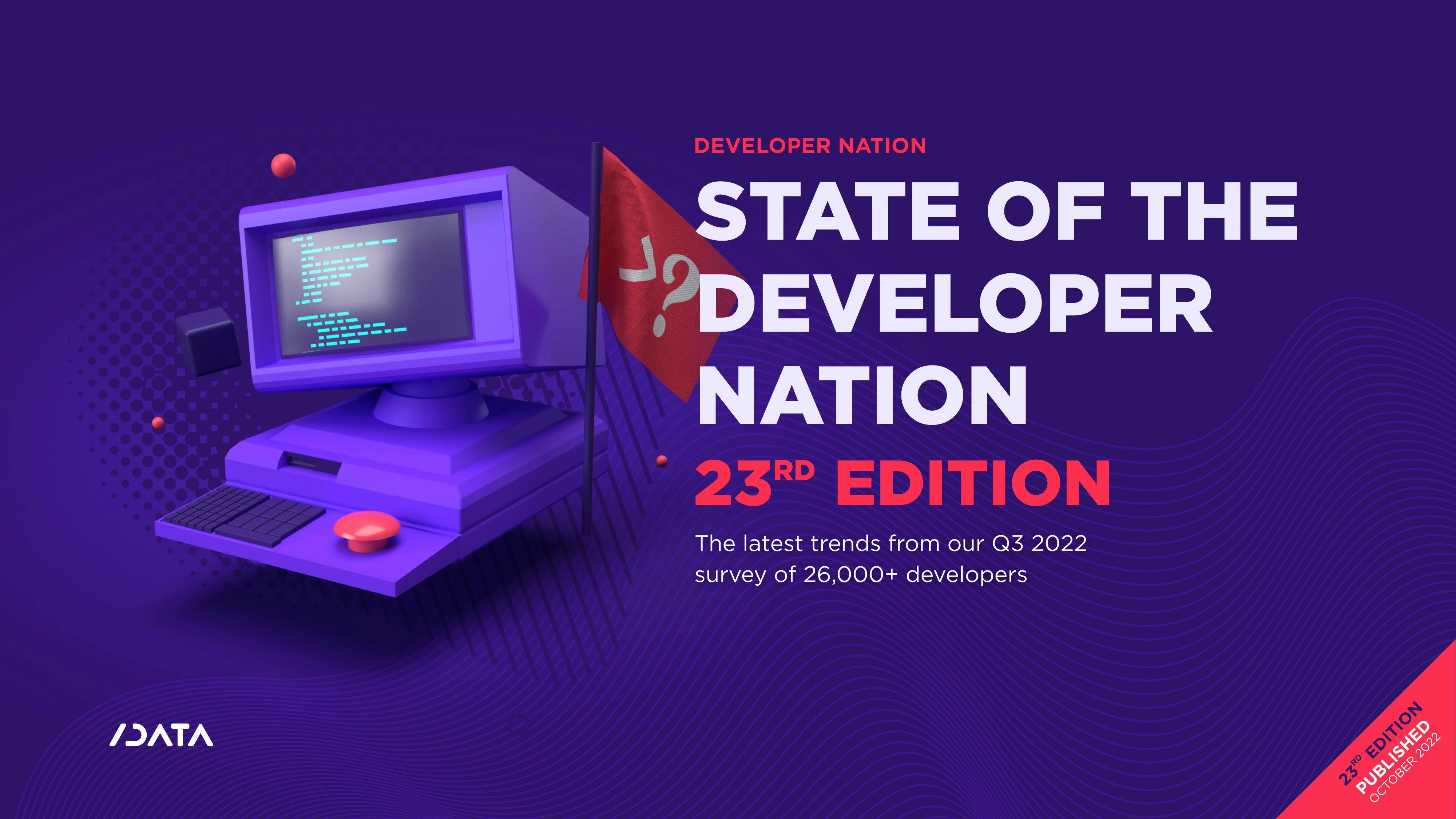
October 31, 2022
State of the Developer Nation 23rd Edition - Q3 2022
SlashData's Developer Nation is the leading research programme on mobile, desktop, industrial IoT, consumer electronics, embedded, third-party app ecosystems, cloud, web, game, AR/VR and machine learning developers*, as well as data scientists, tracking developers' experience across platforms, technologies, programming languages, app and API categories, revenue models, segments, and regions.
*Unless stated otherwise throughout the report, by “developers” we mean everyone who self-identifies as being involved in the software development ecosystem, including individuals holding business (e.g. product managers, C-level executives) and creative (e.g. UI/UX designers) roles.
The 23rd edition of the Developer Nation global survey wave ran from June to August 2022 and reached more than 26,000 developers in 163 countries. This research report delves into key developer trends for Q3 2022 and beyond.
The report focuses on six major themes - each with its own visualisations - showing how the data lends insight into the developer community.
- The state of blockchain development: The distributed transaction ledgers and smart contracts that comprise blockchain technologies have applications in a wide range of industries, particularly in finance, logistics, and government. In this chapter, we focus solely on blockchain applications other than cryptocurrencies, and we explore how developers are involved in blockchain projects and which platforms they target.
- Students’ top career aspirations: Having long-term career aspirations can provide students with a sense of direction and help them make appropriate choices in their pursuit of knowledge. In turn, this speeds up their professional development and increases the likelihood of them achieving a successful career. In this chapter, we look at the top career aspirations of developers who self-identify as students.
- Language communities - An update: Programming languages are often the kernels of strong communities and the subject of opinionated debates. In this chapter, we provide updated estimates of the number of active software developers using each of the major programming languages, across the globe and across all kinds of programmers.
- Why developers contribute to vendor-owned open source projects: Corporate and vendor-owned open source projects combine the values of sharing code, knowledge, and best practices among peer developers with the support from the world’s largest tech companies. In this chapter, we examine what motivates developers to contribute to such projects, across different regions and across different developer segments.
- Types of studios game developers work for: The nature of professional game developers’ work can vary depending on the type of studio they work for. In this chapter, we explore the profile of developers working for different types of game studios, focussing on their level of experience, roles, and technology choices.
- The rise and fall of web frameworks: Web frameworks simplify and accelerate the web development process by enabling developers to abstract access to underlying system resources through a set of high-level APIs. In this chapter, we look at which web frameworks have risen or declined in popularity in the past two years, and we explore the technology choices of the developers who use them.
Methodology
The Developer Nation series of surveys reaches nearly 20,000 respondents from more than 160 countries around the world every six months. As such, it continues to be the most global independent research on mobile, desktop, industrial IoT, consumer electronics, embedded, third-party app ecosystems, cloud, web, game, augmented and virtual reality, and machine learning developers and data scientists combined, ever conducted. The report is based on the 23rd edition of the Developer Nation survey, which was designed, produced, and carried out by SlashData over a period of nine weeks between June and August 2022.
Respondents to the online survey include major app and machine learning development hotspots such as the US, China, India, Israel, the UK, and Russia, even stretching all the way to Kenya, Brazil, and Jordan. The geographic reach of this survey is truly reflective of the global scale of the developer economy. The online survey was translated into eight languages in addition to English, namely simplified Chinese, traditional Chinese, Spanish, Portuguese, Vietnamese, Russian, Japanese, and Korean, and was promoted by more than 80 leading community and media partners within the software development industry.
To eliminate the effect of regional sampling biases, we first weighted to correct for over-represented individual countries within regions. We then weighted the regional distribution across nine regions by a factor that was determined by the regional distribution and growth trends identified in our Developer Nation research. Each of the separate branches: mobile, desktop, Industrial IoT, consumer electronics, embedded software, third-party app ecosystems, cloud, web, games, augmented and virtual reality, and data science and machine learning were weighted independently and then combined.
To minimise other important sampling biases across our outreach channels, we weighted the responses to derive a representative distribution for technologies used and developer segments. Using ensemble modelling methods, we derived a weighted distribution based on data from independent, representative channels, excluding the channels of our research partners, to eliminate sampling bias due to respondents who were recruited via these channels. Again, this was performed separately for each of mobile, industrial IoT, consumer electronics, embedded software, third-party app ecosystems, desktop, cloud, web, games, augmented and virtual reality, and data science and machine learning.
For more information on our methodology please visit https://www.slashdata.co/methodology.
Contact us
Swan Buildings (1st floor)20 Swan StreetManchester, M4 5JW+441612400603community@developernation.net